This post is one in a series following six brewers collaborating to each make a small adjustment to a single recipe in order to improve it, then pass it along to the next brewer. We hope to learn more about the art of recipe creation as we see how other brewers approach the same recipe. The rest of the series can be found here.
Authors: C. McKenzie & T. Bowen
Competition Stouts
My original plan with these collaborative iterations was to have this stout recipe pass through the hands of all six brewers twice, brew one final iteration myself, and enter it into a local homebrew competition (as I did last year with my red IPA). Unfortunately, due to a shipping disaster, the timeline of this plan got thrown off and I knew I wouldn’t receive Iteration 12 until long after the deadline to drop off bottles; needless to say that left me no time for brewing a final version to enter into the competition—at least one that followed the pattern of only making one change from the previous recipe.
So a new plan took shape. Deciding to take advantage of the fact that another brewer participating in this collaborative stout project lives nearby, we both decided to enter a stout into the competition. Both of us took the recipe from the last iteration that we had personally brewed (Iterations 7 & 8,respectively) and made the change(s) that we thought would most improve that recipe. The changes the next brewer made did not necessarily reflect what each of us would have personally changed, since the idea behind this project was to be less insular and instead take a look at what other brewers would change in order to improve a recipe. In short, this offshoot of this series reflected how the stout would have changed if it had remained in the hands of one brewer instead of going to the next brewer to be adjusted.
Since we brewed these beers based on changes to the recipes we had both brewed last time and these brews were somewhat outside of the confines of the rest of this stout project, we’ll call them Iteration 7.1 and Iteration 8.1. Ultimately, these recipes were fairly similar, so we were looking forward to seeing how these beers were perceived by the same judges and how they scored beside each other at the same homebrew competition.
Brew Day
Iteration 7.1:
Oy vey. That’s all I have to say about this brew day.
I was very much looking forward to this brew day, as it was the first truly cold (for the south) brew day of the year. I had set up all my equipment and gathered my water the night before so that all I had to do was light the flame under my strike water when I woke up. Shortly after I had started heating the strike water, I heated some water on my stove in order to preheat my mash tun. I always do this, and I knew it would be especially needed that morning due to the cold temperatures. After preheating the mash tun and reaching my calculated strike water temperature, I doughed in. I let the mash sit for a few minutes before checking the temperature and found it to be sitting at a very low 142⁰F, a full 10 degrees below my target. Awesome.
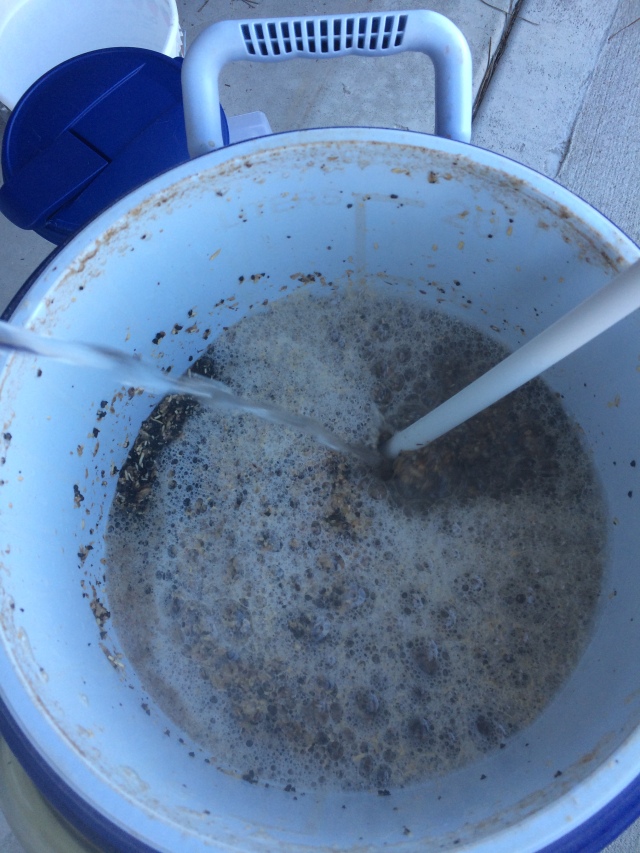
I quickly boiled some water to raise the temperature, but since my mash tun was almost at capacity anyway, I only managed to add enough boiling water to raise the temperature a few degrees. I didn’t really know what else to do other than let it ride.
Bummer #2: While collecting my wort, I decided to gather a bit more than usual for my preboil volume due to the cold weather. Certainly this cold and dry air would impact my boil-off rate, so I should probably gather a little more to ensure I hit my numbers.
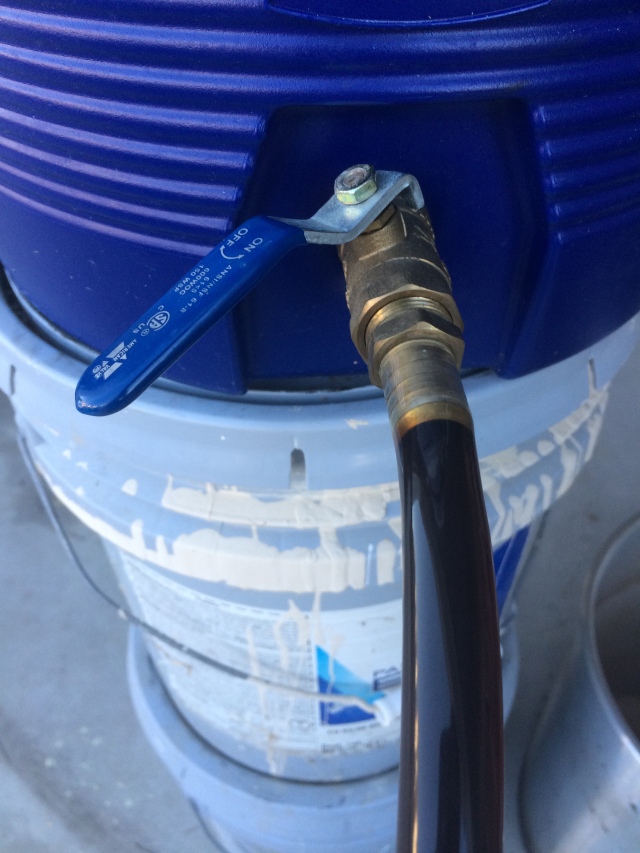
Apparently the day was more humid than I thought or some other factor came into play that I am unaware of, because my evaporation rate ended up being lower than normal—leaving me with roughly a gallon more post-boil wort than desired. My only comfort was knowing that despite my low mash temperature, I would have hit my target OG if not for missing my target post-boil volume. I was 10 gravity points lower than my target, but some quick math showed that the extra gallon would lower the gravity by exactly that much.
Lesson learned.
I couldn’t boil off any more at this point without impacting bitterness (since the hop additions had already been added), so I again decided to just let it ride. I chilled my wort and transferred it into my carboy, which then sat in my fermentation chamber for a couple hours to reach the desired pitching temperature. I pitched the vitality starter I had going and saw activity within a couple hours. Signs of fermentation stopped just two days later, and I let it sit for a couple more days to ensure full attenuation and to let the yeast clean up after themselves before kegging the beer.
Iteration 8.1:
After my last attempt at this beer ended up with a gravity much higher than I wanted, I was eager to rebrew this beer, especially as I really enjoyed the last one after it had sit in the keg a few weeks. So when Chris reached out to me about entering these beers into my homebrew club’s annual competition, I jumped on board immediately.
As I considered what, if anything, I wanted to change from the previous recipe, I kept coming up short. I really enjoyed the previous version and honestly did not want to change much at all. Moreover, the previous version was fermented at ambient temps, and I was anxious to brew essentially the same beer but with temperature-controlled fermentation. The previous version had a lot of odd malt amounts in the grist, e.g., 12 ounces of this, 18 ounces of that, etc. So I made the decision to merely simplify things down to quarter pound increments. I’m mostly convinced at this point that this is what led to my much-higher-than-expected gravity on the previous version—I had so many odd amounts of malt, and they all got bagged together, so I must have gotten more of this or that. Lesson learned, and I get all my malts bagged separately now.
I was coming up on my drop dead date to brew this beer (along with the other beer I was entering in the comp), and my wife and I were still in the throes of moving into our new house. Thankfully, I got a Monday off for Veteran’s Day, so it had to get done that day. In fact, this would be both my first double brew day and my first beers brewed at the new house. The problem was, the new house doesn’t have a brew shed (building it next month!), and it was cold and rainy on brew day. With the wife at work all day, I decided to setup on the front porch with a roof over my head.
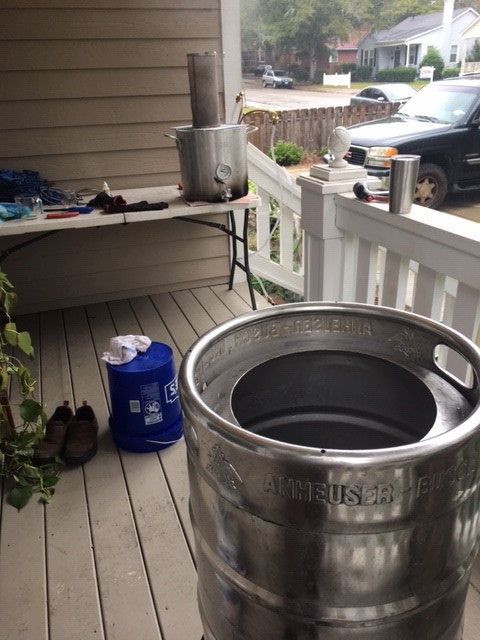
Call it a brain fart, or discombobulation due to brewing in a new spot, but for whatever reason, I neglected to preheat my mash tun with hot tap water, as I usually do. After mashing in, my mash temp came in about 4 degrees lower than I wanted. Oh well, I wrapped it up and put it down for a 60 minute nap.
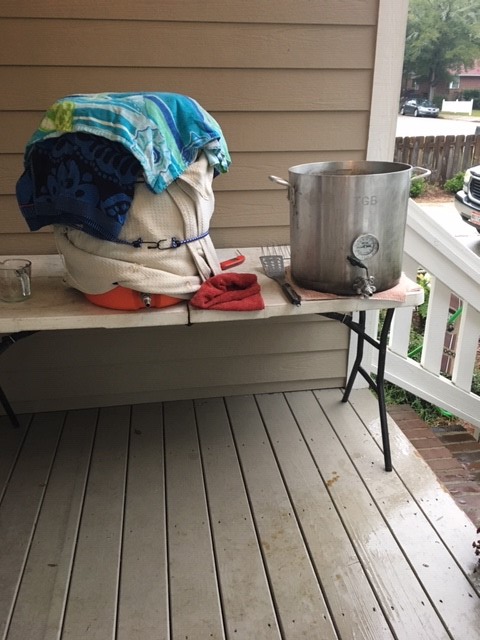
The good news is, despite the cold, damp weather, I didn’t even lose a degree of heat during the mash. While I wanted a mash temp of 154°F, I ended up mashing at about 150°F. I then proceeded to vorlauf, batch sparge, and move on to the boil.
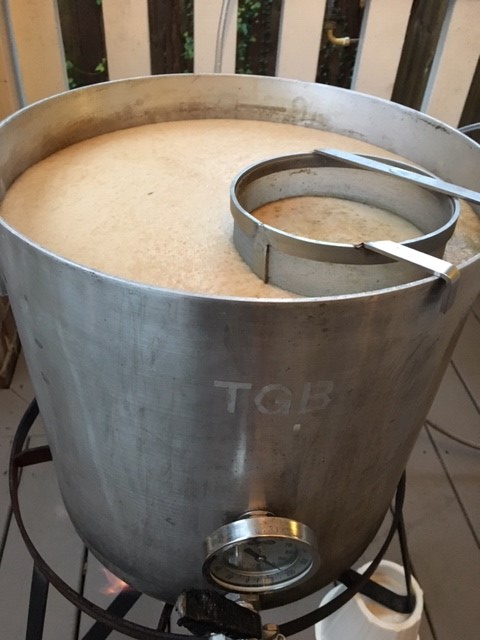
The boil was rather uneventful, and I added hops at the times indicated in the recipe. One thing I did notice, however, was the wort going into the fermenter seemed a tad lighter than the previous version. In fact, it almost looked more like a slightly darker brown ale than a textbook stout.
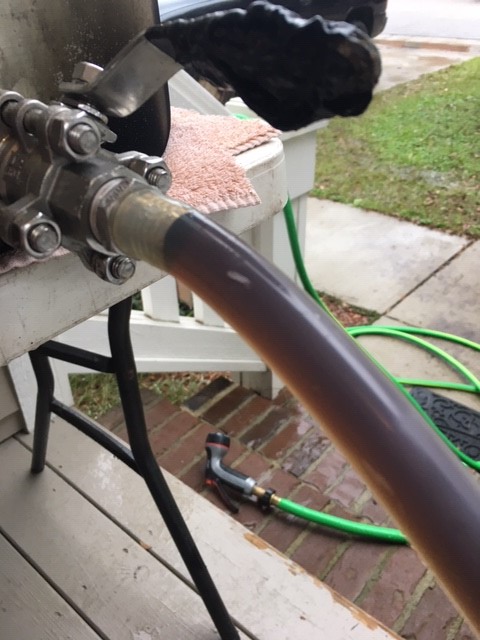
After chilling, I took a gravity sample and was pleased to see it land right at 1.064. Even though this is a few points lower than predicted, I took no issue with it. The NEIPA that I also brewed this day was occupying my main fermentation chamber. But since I didn’t really have much on tap that I was actively drinking, I decided to ferment this stout in the keezer. I put it in the keezer to continue chilling down to pitching temp. Then I hit it with oxygen for about 10 minutes and pitched a 2L starter from a fresh pack of WLP004.
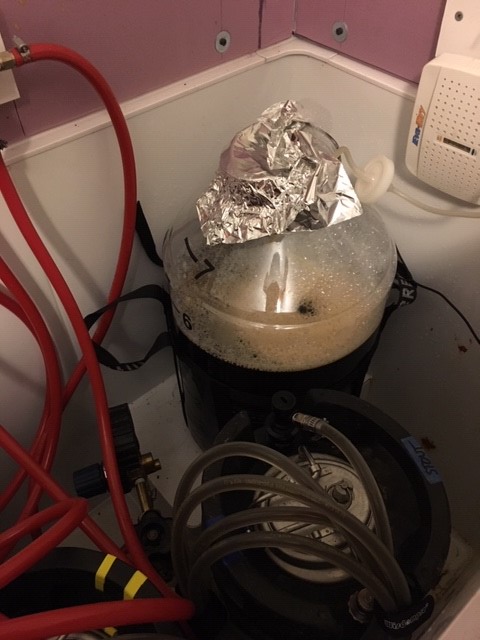
Fermentation was rather uneventful. I pitched yeast at 70°F, then dropped it to 68°F and let it ride out at that temp. After an overnight cold crash, I kegged the beer on day 8.
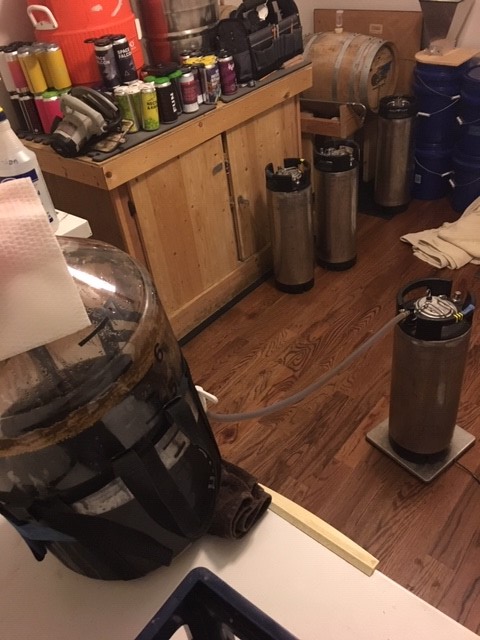
Recipe
Iteration 7.1:
After tasting Iteration 7, I was left with a couple options of what to change. I noted that I wanted to see a return of the stronger toasted flavors that I believed were coming from the Victory malt. I also made the statement that, “the one change I know I would make would be to continue playing with the hops.” The more I thought about that, though, the less I wanted the hops to be my change. I didn’t want to overpower the malt or detract from the roasty and chocolate notes with floral or citrus hop flavors, so I ended up maintaining the hopping schedule and amounts from that recipe. I ended up opting to increase the toasty character of this stout, and I swapped out a couple percentage points of the base malt with some additional Victory.
I also wanted a little more alcohol in the final product than I had achieved last time to bump the beer up into or close to the 6% range. To do this, I decided to drop my mash temperature slightly to hopefully allow for some (but not much) more fermentable sugars to be created while still maintaining a rich and full mouthfeel with a finishing gravity between 1.014-1.018. Of course, as stated above, I ended up lowering my mash temperature much more than intended, which produced both a lower OG and lower FG than desired. The resultant recipe is as follows:
- Mashed at 142-145⁰ F (Target 154⁰F)
- 67.5%. 2-Row
- 12.2% Victory
- 8.1% Roasted Barley
- 8.1% Flaked Barley
- 4.1% Chocolate
- Boiled for 1 hr.
- 1 oz. Nugget (60 min) at 13.3% AA (44.3 IBUs)
- 1 oz. Centennial (5 min) at 9.3% AA (6.2 IBUs)
- Pitched WLP004 Irish Ale Yeast
- OG: 1.055
- FG: 1.012
- ABV: 5.6%
Iteration 8.1:
As mentioned earlier, I really enjoyed the flavor profile the first time I brewed this beer, so I didn’t want to make wholesale changes. This beer further solidified how much I absolutely love pairing Pale Chocolate with Chocolate malt. It gives such a smooth, candy bar chocolate flavor that I love in stouts. Ultimately, the recipe is pretty much the same, but I adjusted amounts slightly to make it easier. I prefer my malts to be in quarter-pound increments, and the previous version had amounts like 18 ounces, which is just annoying. Ergo, this version had a touch less flaked and roasted barley, and a touch more chocolates. With that said, here’s where I landed:
- Mashed at 150°F for 1 hour (Target: 154°F)
- 67.9% 2-Row
- 10.7% Victory
- 7.1% Flaked Barley
- 7.1% Roasted Barley
- 5.4% Pale Chocolate
- 1.8% Chocolate
- Boiled for 1 hour
- 1 oz. Nugget (60 min) at 13% AA (43.3 IBUs)
- 1 oz. Centennial (5 min) at 10.8% AA (7.2 IBUs)
- Water Profile (ppm): [Black Full] Calcium (41); Magnesium (3); Sodium (29); Sulfate (37); Chloride (49)
- Pitched WLP004 (2L starter from fresh pack)
- OG (calculated): 1.069
- OG (actual): 1.064
- FG (actual): 1.014
- ABV: 6.6%
Tasting & Final Thoughts
Iteration 7.1:
This beer poured black with a thick, tan head that had strong persistence. The aroma was strongly roasty, with dark toast, coffee, dark chocolate, and slight floral notes.
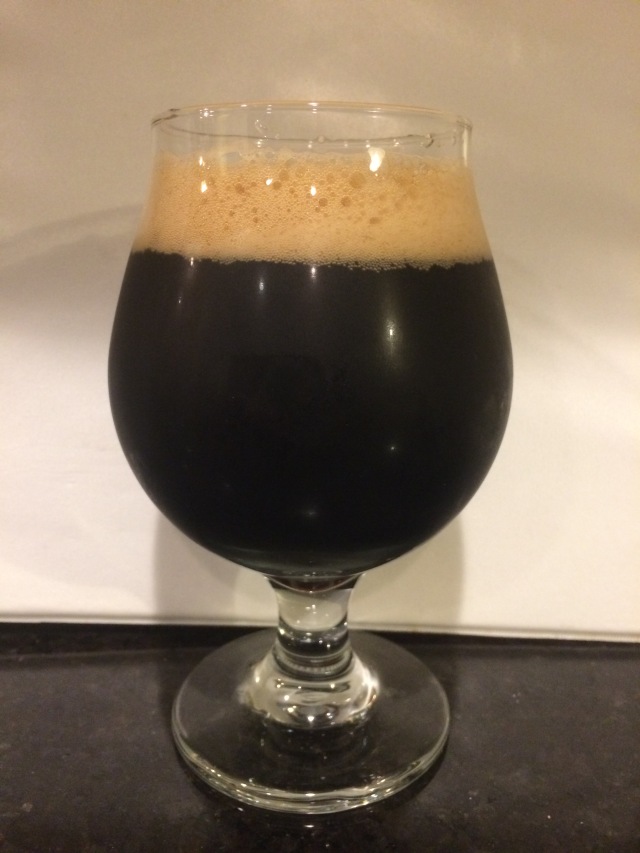
The flavor was very toasty. It also reminded me of coffee—but like biting into a coffee bean (in a good way) and not like drinking coffee. There was a strong chocolate flavor in the aftertaste with a slightly lingering bitterness.
All in all, I think that this recipe is solid. If I changed anything it would possibly be to slightly increase the hop aroma and flavor, but as stated above, I really don’t want to detract from the malt character, which is where I think the focus should be on a stout like this. I really like the strong toasted character in the flavor of this stout, but I wonder if it might be a bit much for some people’s tastes.
What is interesting to me about this project of collaborating on these iterations is that although I made a single change to the version I brewed last and am content to say that this is where I want this stout to be, Iterations 8 and following went down a path that I think produced a completely different beer that I would also be glad to brew. The addition of the pale chocolate malt in Iteration 8 changed the direction of this stout in such a way that following that direction has led to a completely different stout, but one that is delicious on its own merits. I guess what I’m trying to say is that following one path of iterations doesn’t yield the perfect beer; it may lead to a very good beer, but a deviation from that path down another path may very well lead to another very good beer that tastes quite different. For my personal tastes, this last stout that I brewed will likely be my go-to stout recipe for a while, but the variations from Iteration 8 on may very well be beers I brew or may serve as inspiration for changes if I want to brew a stout that is less toasty and more chocolate-forward.
Iteration 8.1:
This beer pours very dark brown. As you can see from the picture, the “brown-ness” is really only evident in the smaller area of the glass (bottom) where light can pass through more easily. The beer is capped off with a nice thick, off-white/tan head.

The nose is black coffee, dark chocolate, with a slight hint of burnt toast. Flavor follows the nose, for the most part, with hints of roast, coffee, and chocolate. At colder (i.e., from-the-tap) temps, I get a lot more dark/baker’s chocolate than I do candy bar chocolate. However, as it warms, more semisweet chocolate emerges and rounds it out a little better than the first few tastes.
I definitely plan to brew this stout again as I feel with a minor tweak here or there this will become my house stout. Changes for next time will likely include the addition of wheat, and more flaked grains. I will likely replace the Victory with wheat. To be quite frank, I’m not sure what Victory is adding to this beer. Regardless of what, if anything, it adds, I think replacing it with wheat will get me closer to what I’m looking for. I like using wheat for body and mouthfeel, and I think this version could benefit from a little more body. I also prefer my stouts a little on the thicker side and I’m more familiar and experienced with flaked oats, so I will likely replace flaked barley with flaked oats and bump it from 7% of the grist to 10%.
Finally, I’d also like to play with the ratio of Chocolate to Pale Chocolate to try and coax out more candy bar chocolate flavors, which were more apparent the first time I brewed this beer. However, I will likely leave that alone for now and see how the other two changes affect the beer.
Competition Results
Iteration 7.1:
You can access the scoresheets for Iteration 7.1 here:
I saved a beer to drink while reviewing the scoresheets, and overall, I generally agree with most of the judges’ comments. I completely agree with the assessments of appearance and mouthfeel. That said, I have to disagree with what one of the judges noted about a lack of coffee in the aroma; I certainly pick up coffee notes in this beer. I do agree with what that same judge said about the strength of the roast in the aroma, though—it’s on the lighter side.
Again, I mostly agree with what was said about the flavor, though I do think that there’s more than just the coffee notes there—which is mostly what the judges commented on. Though, perhaps I perceive more because I know the recipe and have my own set of expectations based on those ingredients.
For the comments in the Overall Impression section, one judge noted that the aroma should be more complex, and if that’s the only negative thing that was said about this beer, I’ll take it.
Iteration 8.1:
You can access the scoresheets for Iteration 8.1 here:
One of my judges noted a “slightly high fill” on my stout. As an aside, I’d like to point out that notes like that really annoy me. Hear me out. First, the bottle inspection does not add nor detract from your score. Second, I fill all of my bottles off the keg; therefore, I typically make an effort to overfill to an extent to mitigate oxidation and keep the beer as carbonated as possible. If it is not a factor in scoring, I don’t care to know about it—of course, descriptor definitions are the exception, because I certainly want to know if a judge detected diacetyl or DMS.
I pretty much agree with both judges on the aroma section as far as dark roasted grains, coffee, and bitter chocolate. However, both noted hops or “earthy hop aroma is present.” I honestly don’t get much hop aroma.
For flavor, one judge noted that it was “quite bitter.” I honestly had not considered that until I read the notes. And I definitely pick up on it now, and I think it’s one of the problems I have with this beer. With all the roasted grains, I think the bitterness needs to be dialed back a touch. I will probably drop the 5m addition of Centennial next time.
One judge noted a “nice creaminess” in the mouthfeel. I get a little creaminess, but I actually want more, hence why I will be adding some wheat to this next time.
Finally, in the Overall Impression section, one judge noted that the bitterness “may be a touch aggressive,” and I definitely agree with that now. However, the other judge noted that his only suggestion was to “derive more bitterness from the grain instead of the hops.” I like the suggestion, I’m just not sure what he means or how to accomplish it. I’m assuming he means rely on the roasted grains for bitterness instead of the hop bill? That’s all I could think of.
Side bar: this beer resulted in something I’ve rarely (never?) experienced before. When I bottle off the keg for competitions, I always bottle two extras. I open one after I get competition results to taste and compare for educational purposes. I hold the other one back a little while longer just as a bit of quality control for my bottling process and seeing how long certain beers hold up when bottled off the keg. I still have some of this beer in the keg, so I recently opened the other bottle to do a side-by-side with a pour from the tap. For reference: I bottled right after kegging and a 24-hour burst carbonation. The keg and the bottle were both right at one month old and were both kept in cold storage. First, the bottled beer was still perfectly carbed (probably slightly overfilled!) and did not show any signs of oxidation in the nose or flavor. But what surprised me was how much better I perceived the bottled beer to be than the keg pour. The bottle had better aroma, particularly big notes of coffee. The bottle had more chocolate flavor. Overall, the bottle tasted better, fresher, and more vibrant. It just seems odd to me because I assumed the opposite would be true. Further research will be done!
Recipe Progression
| Iteration 7 | Iteration 7.1 | |
| Base Malt 2-row | 69.2% | 67.5% |
| Specialty Malt 1 | 10.8% | 12.2% |
| Specialty Malt 2 | 7.8% Roasted Barley | 8.1% Roasted Barley |
| Specialty Malt 3 | 4.4% Chocolate Malt | 4.1% Chocolate Malt |
| Specialty Malt 4 | 7.8% Flaked Barley | 8.1% Flaked Barley |
| 60 min. hop | Nugget: 44.3 IBUs | Nugget: 44.3 IBUs |
| 5 min. hop | Centennial: 6.2 IBUs | Centennial: 6.2 IBUs |
| Yeast | White Labs Irish Ale Yeast (WLP004) | White Labs Irish Ale Yeast (WLP004) |
| OG | 1.064 | 1.055 |
| FG | 1.021 | 1.012 |
| ABV | 5.6% | 5.6% |
| Iteration 8 | Iteration 8.1 | |
| Base Malt 2-row | 68% | 67.9% |
| Specialty Malt 1 | 10.2% | 10.7% |
| Specialty Malt 2 | 7.5% Roasted Barley | 7.1% Roasted Barley |
| Specialty Malt 3 | 1.7% Chocolate Malt | 1.8% Chocolate Malt |
| Specialty Malt 4 | 7.5% Flaked Barley | 7.1% Flaked Barley |
| Specialty Malt 5 | 5.1% Pale Chocolate | 5.4% Pale Chocolate |
| 60 min. hop | Nugget: 44.3 IBUs | Nugget: 43.3 IBUs |
| 5 min. hop | Centennial: 6.8 IBUs | Centennial: 7.2 IBUs |
| Yeast | White Labs Irish Ale Yeast (WLP004) | White Labs Irish Ale Yeast (WLP004) |
| OG | 1.075 | 1.064 |
| FG | 1.012 | 1.014 |
| ABV | 8.3% | 6.6% |
e 2 Accent 5;

This is very big and complex experiment, lot of work required, great job!!!!
I have some questions. What is the color of specialty malts?
Which is your preferable iteration, is the beer getting better as the recipe changes or did some previous iteration left the best impression that cant be changed?
Greetings from Serbia, keep up the good work, cheers!